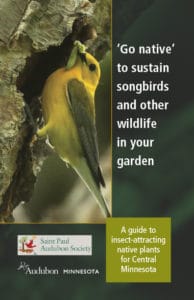‘Go native’ to sustain songbirds and other wildlife in your garden
A guide to insect-attracting native plants for Central MINNESOTA Minnesota
MANY OF US ARE JUSTIFIABLY PROUD of our properties, whether we’re backyard gardeners, farmers or hobby farmers, managers of corporate properties or school grounds, or oversee public spaces. Our landscapes sustain us as we look over our living handiwork. But it’s time to think of our gardens and landscapes as having another role: as places to sustain songbirds and other wild creatures. As the human population grows, there’s less and less room for wildlife. Our gardens and landscapes now are vitally important to preserving and sustaining nature’s diversity–birds, bees, butterflies and others.
The key is native plants. These are adapted to local conditions and generally require less maintenance and fewer resources, such as water and fertilizers, than non-natives. For the last decade there has been a strong trend toward the use of native plants in planning landscapes both large and small. And now people are discovering another reason to plant natives—they attract native, leaf-eating insects. Sound crazy?
Thanks to the St. Paul Audubon Society’s project team (Val Cunningham, Meghan Manhatton, Julian Sellers and Sharon Shinomiya) for researching and writing this booklet, Kim Gordon for graphic design, and Audubon Minnesota’s Ron Windingstad for coordinating efforts with other organizations.


